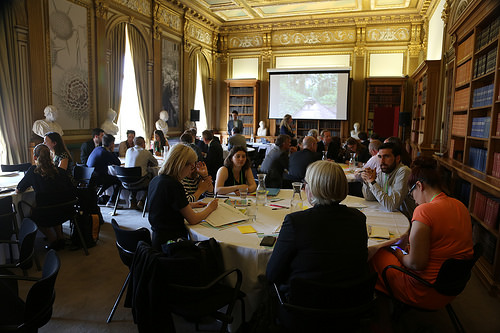In the lead-up to the first formal UNFCCC Subsidiary Body meeting since the Paris Agreement (PA), there was palpable anticipation as to what the meeting would bring in terms of substance and in driving implementation.
We see this focus on implementation more and more, both in the context of the PA as well as for REDD+ and other climate actions. There also appears to be a correlation between the emphasis on implementation and the reliance on the private sector and other non-state actors (NSAs).
The incoming Moroccan COP Presidency made it clear in Bonn during the May conference that COP 22 will be seeking “more meaningful participation of non-state actors”, which was endorsed by the United States. The Green Climate Fund (GCF) has also received a mandate to enhance its engagement with the private sector on the subject of REDD+ through its own private sector facility.
This increasing emphasis on NSAs will provide an interesting new dynamic in the climate negotiations. At Bonn, we saw a glimpse of the things to come in the Closing Plenary of the Subsidiary Body for Implementation on the subject of conflicts of interest and access of NSAs to the process.
Ecuador sought to intervene on a decision on the subject, but a technical system failure prevented them from doing so. This bizarre incident created a rare series of interventions on the subject of the role of NSAs in the climate negotiations and drew out the importance of transparency and the need for the UNFCCC to put in place a policy concerning NSAs and conflicts of interest.
It is an issue being raised by many CSOs and governments out of concerns related to the influence of vested interests within the climate negotiations. Ecuador’s intervention on this topic was supported by almost the entire developing world. Venezuela made the forceful point that it sets a very dangerous precedent to deny the request of countries representing 80% of the global population over a mere technical issue.
This article looks at the progress made in Bonn on the items most applicable to land, forests and REDD+ and the markets and non-markets discussion and transparency. It provides insight into issues associated with the emerging emphasis on NSAs for implementation of the PA.
HOW TRANSPARENT WILL THE NEW TRANSPARENCY FRAMEWORK BE?
Parties expressed clear views that the new ‘enhanced’ transparency framework was the heart of the new regime. Using guiding questions proposed by the co-facilitators concerning experience with MRV, enhanced action and support, and the notion of ‘flexibility,’ the Parties engaged in a useful exchange of views on the subject.
The notion of ‘flexibility’ contained in the PA intends to reflect common but differentiated responsibilities and equity. However, there are different views as to how this should be interpreted. Some take a broader approach, suggesting flexibility would be applicable to the entire system based on a nationally-determined, opt-in approach, while others expressed a view that a more methodological approach to the subject should be taken to determine how different parts of the transparency system should reflect the principle of ‘flexibility’. Many countries made the point that ‘flexibility’ should not be used as an excuse to not participate.
South Africa, on behalf of the African Group, put forward some useful criteria for consideration that within the notion of ‘flexibility’ is the need to build capacity; continuous improvement over time; and building on current experiences.
The current tiered system of accounting was raised as one useful existing tool, as were the processes in place concerning Forest Reference Emissions Level / Reference Emissions Level Technical Assessments, National Communications, Biennial Reporting, Biennial Update Reporting, International Consultation and Analyses and International Assessment and Review, and how these processes now should be aligned with Nationally Determined Contributions and to inform the Global Stocktake.
The stepwise approach adopted in the REDD+ Framework, the safeguards information system and independent monitoring systems at the national level could also be considered.
Despite the many calls for private sector engagement in implementation, a recent study of seven countries across Asia identified the lack of inclusion of the private sector in the INDCs of Bangladesh, Cambodia, India, Indonesia, Lao PDR, Thailand and Vietnam. It may be that the new transparency system will require the provision of information from NSAs at the national level.
It becomes particularly important in the context of the biomass industry when considering the level of reliance on bioenergy to achieve 1.5-degree pathways in the recent IPCC AR 5 report. It could be equally important in the context of zero deforestation supply chain commitments, for example through the New York Declaration on Forests as well as decarbonization plans. The Standing Committee on Finance Forum in 2015 identified that a lack of access to information from the private sector is a significant barrier to understanding the landscape of forest finance.
Many express the view that the new arrangements need to build on existing arrangements under the Convention. It will be important to look at what currently exists and how to build new rules on transparency, including accounting related to land use. If this gap related to disclosure of information from the private sector is addressed, it may be one way to seek more meaningful participation by NSAs as a part of the enhanced transparency framework, whilst also addressing conflicts of interest.
Parties have been invited to submit their views on modalities, procedures and guidelines concerning transparency by 30 September 2016.
THE ‘MECHANISM’ WITH NO NAME AND NON-MARKETS
Article 6 of the PA contains the provisions on the new ‘mechanism’, which very deliberately does not mention markets, except in the context of ‘non-markets’.
Efforts were made to understand what is meant by ‘internationally transferred mitigation outcomes’, or ITMOs, with positions being stated that these ITMOs should include countries’ mitigation outcomes achieved abroad; ensure environmental integrity; avoid double counting; and have robust accounting. Disagreement arose around the topic as to whether ITMOs give rise to a new type of tradable ‘unit’.
It remained unclear as to whether REDD+ would be included in this new ‘mechanism’. There is a reluctance on the part of many developing countries to transfer their emissions reductions as they would prefer to attribute them against their own INDC or NDC targets.
It seemed clear from the discussions that this new ‘mechanism’ established under the PA would build on the current Clean Development Mechanism. It will now be necessary for the lessons learned and differences between the two to be clearly identified.
There is a reluctance on the part of many developing countries to transfer their emissions reductions.
The non-market discussion also made some progress under the SBSTA with emphasis being on the question as to what a ‘non-market’ approach is. Some consider this to include activities such as the development of national climate policies, governmental decision-making and enabling conditions to implement adaptation and mitigation actions.
Others focused on the synergies between adaptation, mitigation and means of implementation and could include REDD+, expressing interest in exploring this further. Many agreed that such approaches do not give rise to any form of tradable unit. However, the query was raised as to whether a non-market approach could mean an investment by private sector that does not create such tradable units.
Submissions from Parties and Observers on the topics of markets and non-markets are due by 30 September 2016.
A MUTED SIGNAL FROM THE REDD+ FOCAL POINTS
The third meeting of REDD+ voluntary focal points was held with several useful updates on its progress. Indonesia highlighted its achievements related to MRV and data collection, including those related to peatland emissions. Ghana placed emphasis on non-carbon benefits and Brazil confirmed that its three gigatons of emissions reductions would be put before the Green Climate Fund before the end of 2016.
A presentation was given by the governments of Germany, Norway and the United Kingdom concerning their efforts to scale up climate finance for REDD+ under the joint initiative that has become known as the GNU.
This joint initiative is partnering with the private sector to transform supply chains and is committed to addressing barriers to, and building the economic case for, REDD+. Panama strongly supported the need to bring private sector finance to REDD+, pleading with the international UNFCCC community to send a stronger signal to trigger private sector investment as well as seeking a signal from the UNFCCC to the International Civil Aviation Organization, which is considering significant forest carbon offsets, to not do anything that could undermine the Warsaw REDD+ Framework.
The GCF secretariat presented its progress concerning the decisions made in March 2016 concerning the RBPs draft decision, which will be presented in either September or October and discussions are occurring between the GCF and the private sector concerning forests and land use.
CSOs and indigenous groups are raising concerns, seeking consultations and transparency. The GCF Secretariat confirmed that there is currently no mandate from the Board to undertake public consultations on its work concerning REDD+. Brazil confirmed it will be working closely with the GCF to put in place measures to make payments for results and AILAC mentioned it would be presenting a statement on RBP to the GCF Board at the next meeting to be held in July.
Some disagreement emerged towards the end of the meeting. When Panama called for recommendations to be made about RBPs and to scale up finance and private sector engagement, Germany and Norway intervened, making the point that the meeting is informal and has no power to be making such recommendations.
OPPORTUNITY SELDOM KNOCKS TWICE
Many approached the session cautiously, with both old and new issues put on the table. There was a fine line to walk between negotiating the detail to implement the PA without reopening points of agreement reached in Paris. The controversy related to NSAs, which occurred on the final day, took many by surprise.
It is correct to say that the private sector will be critical in dealing with climate change, and so the UNFCCC has now opened the Pandora’s box through its decision concerning NSA engagement on the topic. It will need to address this within its own policies, especially in the transparency framework.
Conflicts of interest are an important legal issue that most organizations include in their policy framework. It is surprising that there is no such policy in place at the UNFCCC. This may present a delicate opportunity that could contribute to the necessary transformational change that needs to come from the PA.
We want you to share Forests News content, which is licensed under Creative Commons Attribution-NonCommercial-ShareAlike 4.0 International (CC BY-NC-SA 4.0). This means you are free to redistribute our material for non-commercial purposes. All we ask is that you give Forests News appropriate credit and link to the original Forests News content, indicate if changes were made, and distribute your contributions under the same Creative Commons license. You must notify Forests News if you repost, reprint or reuse our materials by contacting forestsnews@cifor-icraf.org.


